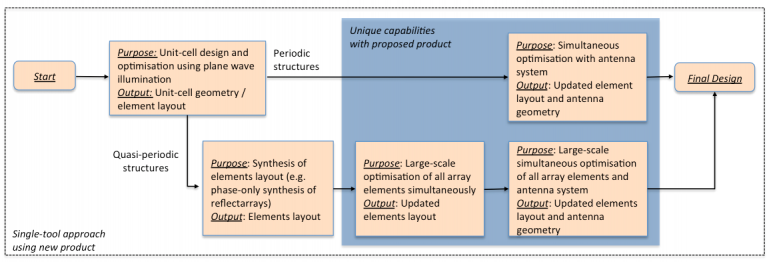-
StatusCompleted
-
Status date2018-07-25
-
Activity Code5B.158

Periodic and quasi-periodic surfaces that can either reflect or transmit electromagnetic fields when illuminated by an external source have existed for several decades, e.g., frequency/polarisation selective surfaces, reflectarrays, etc. Usually these surfaces consist of several thousands of array elements, thus an appropriate and efficient synthesis is a challenging task and the design of such surfaces is often done at the unit-cell level.
The goal of the present activity is to develop a single software tool that allows the RF analysis and optimisation of advanced reflector antenna systems that consist/involve periodic or quasi-periodic surfaces. The main features are highlighted in the figure below.

The main challenge in this project is the development of a direct optimisation scheme that allows the optimisation of all array elements in a periodic/quasi-periodic surface together with the antenna system simultaneously.
Although periodic/quasi-periodic surfaces have existed for several decades, e.g., reflectarrays, the performance of such surfaces is still not competitive with existing reflector solutions. The lack of accurate and reliable design tools is a major obstacle. It is anticipated that the new product can be used to enhance the performance of antenna systems consisting of periodic/quasi-periodic surfaces and thereby enabling a number of new applications.
The new product contains a number of fast and accurate RF analysis methods dedicated for periodic structures. At the same time, more general solvers are also included which can be used to analyse arbitrarily shaped periodic structures. The main feature of the product is capability of optimising all array elements (several thousands) in a periodic/quasi-periodic surface simultaneously to fulfil a certain optimisation specification. This has proven to provide better designs than existing methods. The combination of the advanced reflector modelling capabilities in GRASP and the new product offers a software tool with unique capabilities.
The new product will be fully integrated into the existing GRASP software and ensures a pleasant user experience for customers with licenses for both GRASP and the new product. The new analysis capabilities are built into the GRASP back-end which also allows batch runs of large problems.
The project plan was divided into two parts. The electromagnetic models was developed in the first part, and fully integrated into the existing GRASP software in the second part. Validation using realistic use cases was performed before completion of the activity.
The development has been completed.


